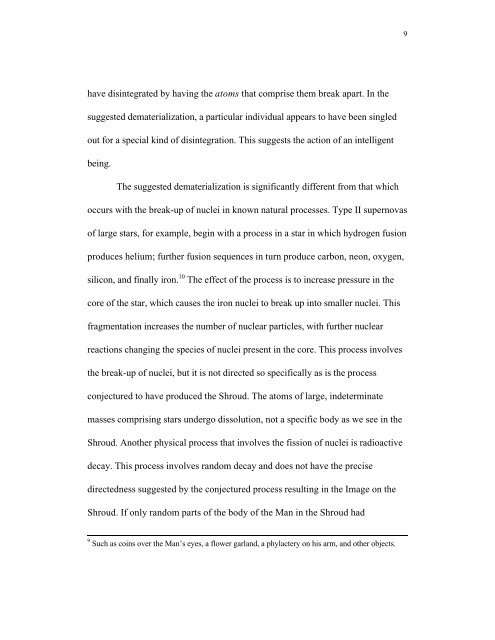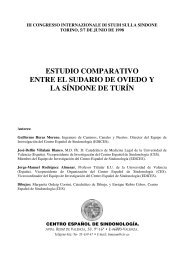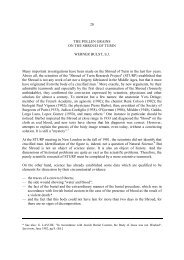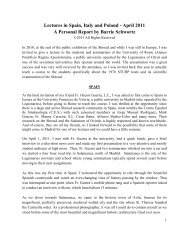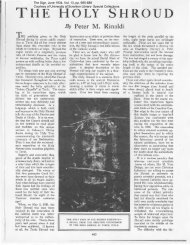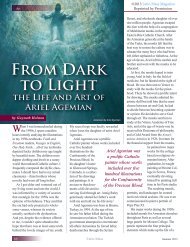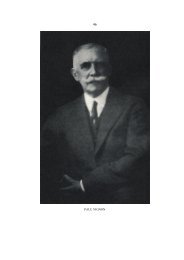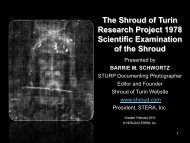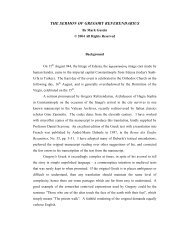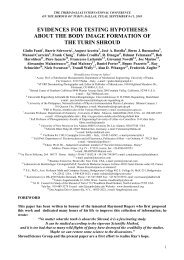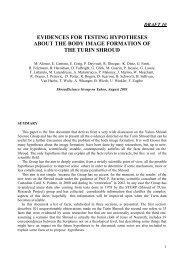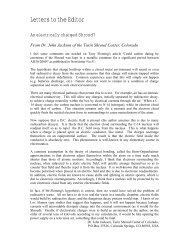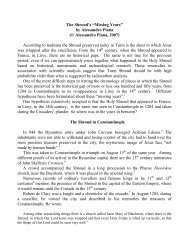Design in the Shroud of Turin - The Shroud of Turin Website
Design in the Shroud of Turin - The Shroud of Turin Website
Design in the Shroud of Turin - The Shroud of Turin Website
You also want an ePaper? Increase the reach of your titles
YUMPU automatically turns print PDFs into web optimized ePapers that Google loves.
9have dis<strong>in</strong>tegrated by hav<strong>in</strong>g <strong>the</strong> atoms that comprise <strong>the</strong>m break apart. In <strong>the</strong>suggested dematerialization, a particular <strong>in</strong>dividual appears to have been s<strong>in</strong>gledout for a special k<strong>in</strong>d <strong>of</strong> dis<strong>in</strong>tegration. This suggests <strong>the</strong> action <strong>of</strong> an <strong>in</strong>telligentbe<strong>in</strong>g.<strong>The</strong> suggested dematerialization is significantly different from that whichoccurs with <strong>the</strong> break-up <strong>of</strong> nuclei <strong>in</strong> known natural processes. Type II supernovas<strong>of</strong> large stars, for example, beg<strong>in</strong> with a process <strong>in</strong> a star <strong>in</strong> which hydrogen fusionproduces helium; fur<strong>the</strong>r fusion sequences <strong>in</strong> turn produce carbon, neon, oxygen,silicon, and f<strong>in</strong>ally iron. 10 <strong>The</strong> effect <strong>of</strong> <strong>the</strong> process is to <strong>in</strong>crease pressure <strong>in</strong> <strong>the</strong>core <strong>of</strong> <strong>the</strong> star, which causes <strong>the</strong> iron nuclei to break up <strong>in</strong>to smaller nuclei. Thisfragmentation <strong>in</strong>creases <strong>the</strong> number <strong>of</strong> nuclear particles, with fur<strong>the</strong>r nuclearreactions chang<strong>in</strong>g <strong>the</strong> species <strong>of</strong> nuclei present <strong>in</strong> <strong>the</strong> core. This process <strong>in</strong>volves<strong>the</strong> break-up <strong>of</strong> nuclei, but it is not directed so specifically as is <strong>the</strong> processconjectured to have produced <strong>the</strong> <strong>Shroud</strong>. <strong>The</strong> atoms <strong>of</strong> large, <strong>in</strong>determ<strong>in</strong>atemasses compris<strong>in</strong>g stars undergo dissolution, not a specific body as we see <strong>in</strong> <strong>the</strong><strong>Shroud</strong>. Ano<strong>the</strong>r physical process that <strong>in</strong>volves <strong>the</strong> fission <strong>of</strong> nuclei is radioactivedecay. This process <strong>in</strong>volves random decay and does not have <strong>the</strong> precisedirectedness suggested by <strong>the</strong> conjectured process result<strong>in</strong>g <strong>in</strong> <strong>the</strong> Image on <strong>the</strong><strong>Shroud</strong>. If only random parts <strong>of</strong> <strong>the</strong> body <strong>of</strong> <strong>the</strong> Man <strong>in</strong> <strong>the</strong> <strong>Shroud</strong> had9 Such as co<strong>in</strong>s over <strong>the</strong> Man’s eyes, a flower garland, a phylactery on his arm, and o<strong>the</strong>r objects.


